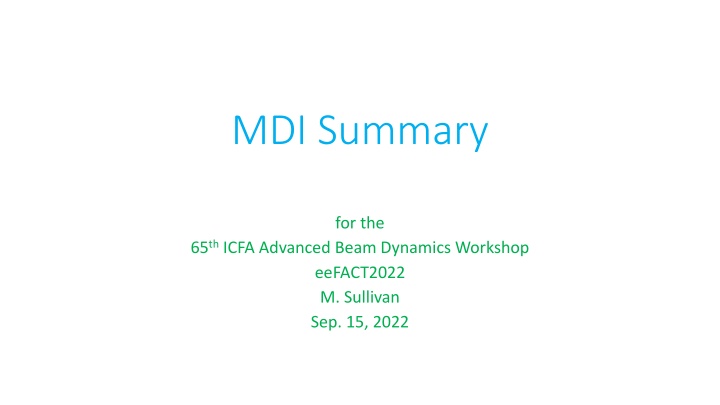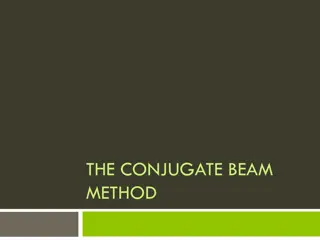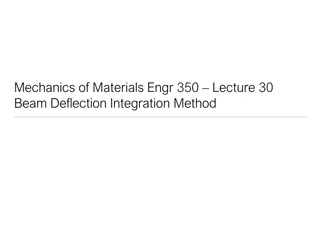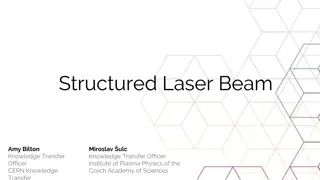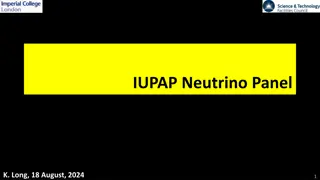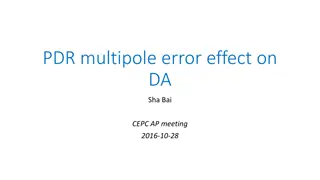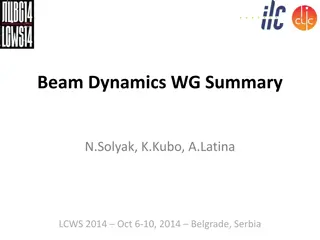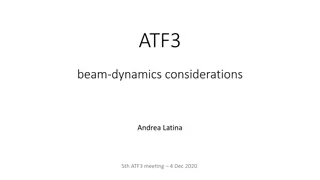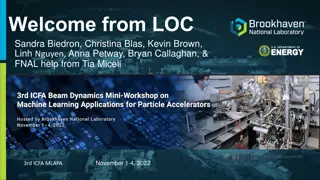Highlights of the 65th ICFA Advanced Beam Dynamics Workshop
The 65th ICFA Advanced Beam Dynamics Workshop featured insightful presentations on high currents, luminosity, and beam behaviors. Topics included beam pipe scrubbing, non-gaussian beam tails, and detector backgrounds. Presenters discussed progress in FCCee design, focus magnets, and beampipe concepts. Detailed analyses of superKEKB backgrounds and MC simulations were also showcased. The event provided a valuable overview of cutting-edge research in beam dynamics and accelerator physics.
Uploaded on Sep 20, 2024 | 3 Views
Download Presentation

Please find below an Image/Link to download the presentation.
The content on the website is provided AS IS for your information and personal use only. It may not be sold, licensed, or shared on other websites without obtaining consent from the author.If you encounter any issues during the download, it is possible that the publisher has removed the file from their server.
You are allowed to download the files provided on this website for personal or commercial use, subject to the condition that they are used lawfully. All files are the property of their respective owners.
The content on the website is provided AS IS for your information and personal use only. It may not be sold, licensed, or shared on other websites without obtaining consent from the author.
E N D
Presentation Transcript
MDI Summary for the 65thICFA Advanced Beam Dynamics Workshop eeFACT2022 M. Sullivan Sep. 15, 2022
MDI WG5 There were many very interesting presentations on several topics I will try to describe them The descriptions will have to very brief, and I hope to give you a glimpse of the various presentations This is a whirlwind tour with about 3 slides from each presentation 2
Plenary session Mike Sullivan presented some issues regarding high currents and high luminosity High beam currents mean beam pipe scrubbing leads to non-gaussian beam tails Large non-gaussian beam tails leads to short lifetimes and high detector backgrounds He showed some examples of second gaussian beam tail models Tail distributions that can generate the background level seen in the superKEKB pixel detector (PXD) during early running. They also approximately agree with the measured beam lifetime. The one-day lifetime is derived by Matt Sands, The Physics of Electron Storage Rings an Introduction , 1970, SLAC-121 3
Plenary MDI WG5 I also mentioned the backgrounds from high luminosity Many of these background sources are mentioned in more detail in following talks The second talk was by Manuela Boscolo and was about MDI progress for the FCCee design Manuela showed progress on several fronts Final focus magnets Inner beampipe Initial assembly concepts 4
FCCee 5
FCCee 6
FCCee 7
WG5 Plenary (cont.) Following Manuela s talk we had two very interesting talks by Andrii Natochii about superKEKB backgrounds The first showed the current status of background measurements compared to MC simulation The measurements divided by the MC simulation are all approaching one The second presentation described in more detail the MC background simulator The simulation of the detector and local region has gradually improved, and this has been a major factor in getting good agreement between MC and data 8
SuperKEKB background sources studied by the background team 9
SuperKEKB 10
SuperKEKB 11
SuperKEKB MC details: All possible places filled with shielding 13
SuperKEKB MC details: Improving the model of the tunnel +/- 30 m This is very impressive 15
Parallel session We also had a parallel session with five very interesting presentations Sha Bei gave up an update on the MDI design for CEPC Calculating and controlling background levels from various sources Sasha Novokhatski presented studies of HOM power in the FCCee IR Current HOM power levels are under control Andrea Ciarma talked about background studies for FCCee IR Discussed a very interesting list of backgrounds Finds a very high-power beam of photons from Beamsstrahlung Holger Witte presented the FF design elements for the EIC Presented a very detailed magnet study of the IR magnets Antonio De Domenico discussed the possibility of a zero-angle detector for a fast luminosity measurement This possible signal has to be found inside the Beamsstrahlung photon beam 16
CEPC MDI 17
CEPC MDI 18
CPEC MDI: looking at SR on collimators Also loss factors and impedance calculations 19
FCCee IR HOM: Initial larger IP pipe design needed a HOM absorber 20
FCCee IR HOM: Smaller IP beam pipe reduces the trapped HOM power 21
FCCee HOM: The beam pipe discontinuities generate a lot of power but most of it now travels outside of the IR All of this power must still be accounted for 22
FCCee machine induced backgrounds This is in addition to the e+e- pairs produced by the luminosity part of the collision 23
FCCee machine bkgds SR masking schemes generally can reduce the SR background to the scattering of SR photons near the tip of the masks 24
FCCee machine bkgds: Beamsstrahlung This source generates a powerful beam of photons which escape the IR but deposit an enormous amount of energy on the downstream beam pipe near the first bend magnet. The power in this beam is almost 1% of the total SR power for the ring (50 MW) at the Z pole. There are eight of these beams for a 4 IP design 25
EIC IR 26
EIC IR magnets 27
EIC magnets 28
FCCee Fast lumi detector: LEP experience 29
FCCee Fast lumi detector: LEP experience 30
FCCee Fast lumi detector at FCCee It is recognized that this lumi signal may be difficult to dig out of the Beamsstrahlung photon beam, but the detector could still be very useful especially in the early running 31
Conclusions I have tried to convey a quick glimpse from all of the excellent presentations we had in WG5 I have left out many topics from each presentation that merit further review I encourage anyone interested in more detail to go directly to the talks I think this part of the writeup will be a very useful and important reference Thank You 32
